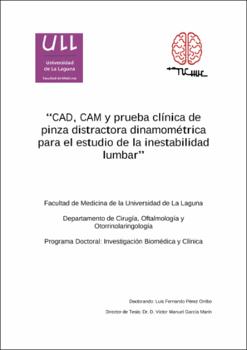Cad, Cam y prueba clínica de pinza distractora dinamométrica para el estudio de la inestabilidad lumbar
Fecha
2015Resumen
A lo largo de los últimos años, la enfermedad degenerativa de raquis lumbar,
junto con la lumbalgia o lumbociática consiguientes, se han consolidado como uno de
los motivos más frecuentes de consulta médica a nivel de atención primaria.
Constituyen la segunda causa más frecuente de baja laboral en el mundo
desarrollado, tras las infecciones respiratorias de vías altas, ocasionando un gasto
anual de unos 10.000 millones de dólares en los Estados Unidos de América.
Dentro de esta amplia entidad, la inestabilidad a nivel de los segmentos
móviles lumbares, entidad que agrupa a dos vértebras lumbares adyacentes, el disco
que las articula, y todo el complejo músculo-ligamentoso que las estabiliza,
constituye una de las claves de estudio. Para el tratamiento de esta inestabilidad se
han diseñado numerosos sistemas, como son los sistemas de artrodesis (tornillos
transpediculares, PLIF, TLIF, ALIF,….) que buscan como fin último la fusión ósea
entre dos o más vértebras adyacentes, con la consiguiente estabilización del raquis, y
disminución del dolor.
Otra aproximación terapéutica a este problema se realiza a través de los
distintos implantes interespinosos que existen en el mercado. Este tipo de implantes
(Wallis©, Bio-Lig©, Diane©, In-Space©, etc), buscan limitar el movimiento del
segmento móvil lumbar, disminuyendo los desplazamientos cefalocaudales de dicho
segmento durante la flexo-extensión lumbar. Esto se consigue a través de la
colocación de dichos implantes a nivel del espacio interespinoso, con un componente
que limita la aproximación de ambas apófisis espinosas durante la extensión lumbar y
un ligamento artificial que limita la distracción de las mismas durante la flexión.
Este tipo de implantes interespinosos, al limitar la movilidad del segmento lumbar,
disminuyen el estrés al que se ve sometido el mismo, con lo que, en teoría, frenan o
incluso revierten el proceso degenerativo en curso.
Durante los últimos años, tanto las técnicas de artrodesis, posterolateral,
intersomática o 360º, como las técnicas de estabilización interespinosa lumbar han
experimentado un gran auge, constituyendo herramientas de inestimable valor para
el neurocirujano a la hora de tratar la enfermedad degenerativa del raquis lumbar.
Sin embargo, hasta el día de hoy no se ha implementado un método, validado científicamente, que permita sentar una indicación objetiva del uso de este tipo de
implantes dejándose al criterio del cirujano la colocación o no de los mismos. During the last years, lumbar spinal degenerative disease, along with lumbago
or lumbosciatica have been consolidated as one of the most frequent reason of
consultation in primary medical care. They have become in the second most frequent
reason for temporally disability in developed countries, behind upper respiratory
infections, representing an annual cost over 10.000 million dollar in the Unites States
of America.
Into this spread pathology, lumbar motion segment´s instability is one of the
keys for researchers. Motion segment (MS) is a concept that includes adjacent
vertebrae, intervertebral disc and the whole muscle-ligaments complex that stabilize
then. Many different systems have being designed for motion segment´s instability
treatment. Since interspinous devices to fusion instrumentations, such as
transpedicular screws, TLIF, PLIF, ALIF etc., have being developed to stabilize or fuse
a hypermobile motion segment, reducing the pain generated by the instability.
Intespinous devices have shown great advances during the last two decades.
This kind of implants, (Wallis©, Bio-Lig©, Diane©, In-Space©, etc), are designed to
limit motion segment´s motion, by limiting the extension and flexion, through its
positioning at the Interspinous space. By limiting movement, the motion segment´s
stress is reduced, so theoretically we would decelerate the degenerative process.
Despite its development, to our days there is not an objective way of indicates the
use of this kind of devices, leaving it to surgeon’s preferences.
Until now, in order to make that decision, spinal surgeons employed different
paths. On one hand, and extensive preoperative study is performed, both clinical and
radiological, in order to find any trace of basal instability, that would probably
require a stabilization procedure. On the other, through the Key test, (Key et al,
1945), by grapping and pulling both spinous processes and deducing MS´s instability
from the tactile feedback of the surgeon. This method, as we will expose during this
study, is completely subjective, and surgeon´s dependent.
The initial idea of this study born during a lumbar microdiscectomy, when we
wondered in which easy, quick and objective way we could be able to measure segmental instability, without changing our surgical strategy. This measurement is
important, not only in order to have an initial quantification of the MS´s instability,
but to objectivize how it changes along the whole surgical procedure. In this manner
we could be able to quantify its evolution objectively.
Within a clinical environment where resource´s optimization and cost´s saving
are fundamental, a surgical tool that could help us to decide objectively when to use
or to discard a supplementary segmental stabilization would constitute a priceless
instrument.





